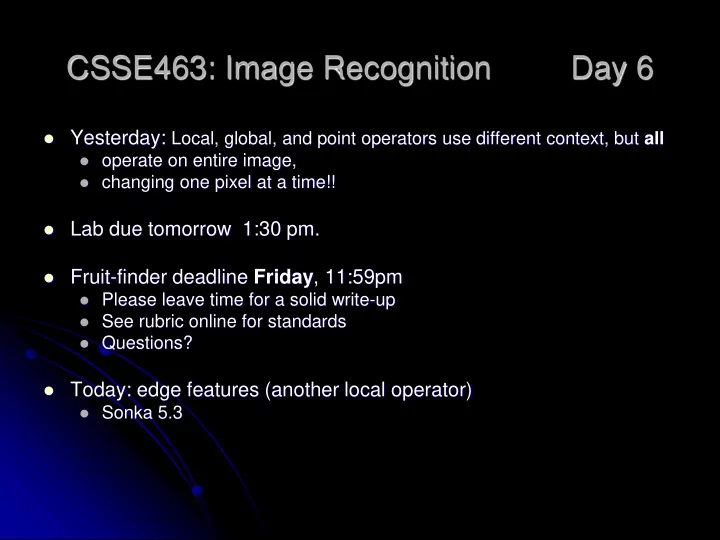

CSSE463: Image Recognition Day 6 Yesterday: Local, global, and point operators use different context, but all operate on entire image, changing one pixel at a time!! Lab due tomorrow 1:30 pm. Fruit-finder deadline Friday , 11:59pm Please leave time for a solid write-up See rubric online for standards Questions? Today: edge features (another local operator) Sonka 5.3
There are only two people in this world: 1. Those who index their arrays starting at 1 1. Those who index their arrays starting at 0 Thanks to 463 student Thomas Root for clarifying this for us.
Edge Features – Why? “Edginess” (# edges) and their directions can give you info about the scene content Orientation of the image Natural vs. manmade images Edges can be used to segment the image. Color information is usually used as well. Specifically, boundaries occur where the chroma and/or luminance change (drastically). We could use to enhance the fruit-finder in a later assignment ( not now).
Outline for next 2 sessions Concept: How to find “edges” in 1D signal Edges in 2D images Limitations Edges vs edgels, Canny edge detector
Intuition: Finding edges What’s an edge? Image How to find changes in intensity? Intensity How to find first derivative? First deriv.
Finding derivatives (1D) Let y be intensity of point at location x D Def: y y D x x Fix D x = 1 pixel dy/dx = y 2 -y 1 f: [0 0 0 0 0 50 50 50 50 0 0 0 0 0]; f’:[ 0 0 0 0 50 0 0 0 -50 0 0 0 0 ]; Correlate image with filter [-1,1] to find positions of change. Edges “between” pixels. What is significance of magnitude of first deriv. ?
Applying Filters Example for differential with D x = 2 pixels: (Better; no output “between” pixels) Image 5 8 9 1 2 2 1 2 1 3 1 3 ½ - ½ 0 ½ - ½ ½ 0 - ½ 0 Mask … -3.5 -3.5 Output 2 Could you do Ramps? Impulse? Step edges? (on quiz) Properties Q1,3 If no contrast?
Why should the values in an edge filter sum to 0? What if they didn’t? Consider running it on a homogeneous region: 40, 40, 40, 40, 40, 40 Q2
2D Edges Local operators Prewitt operators Sobel masks Roberts 2x2 cross-operators Gradient: magnitude Gradient direction
Gradients Vector pointing in direction of greatest change: We want its magnitude and direction f y f x f
1. Find partials using filters 1 0 1 1 0 1 f 1 1 To find , use Prewitt : 1 0 1 or Sobel : 2 0 2 filter x 6 8 1 0 1 1 0 1 1 1 1 1 2 1 f 1 1 To find , use Prewitt : 0 0 0 or Sobel : 0 0 0 filter y 6 8 1 1 1 1 2 1 Note that this is 1D filter, but averaged over 3 rows (for df/dx) or 3 cols (for df/dy) and with 1/6 factored out to allow integer multiplication 0 1 1 0 Roberts 2x2 cross operators , are more sensitive to noise 1 0 0 1 Q5
Demo My homemade edgefinder Finds vertical and horizontal edges using filters Combines to find edge magnitude Combines to find edge direction Re-scale for display Similar to part of Lab 3. So I can’t post code
2. Find edge gradient magnitude f Definition: the gradient, , is the vector pointing in the direction of greatest change. To find its magnitude: 2 2 f f f x y Q2
3. Find edge gradient direction tan -1 (y,x) Matlab’s atan2(y,x) gives full range, [- p, p] dir=arctan(-1,0) = - p /2 dir=arctan(0,-1) = p dir=arctan(0,1)= 0 dir=arctan(1,0)= p /2 Direction is thus the angle formed by the x-axis and the line “pointing towards” light region. Q3-4
Color edges Rarely used historically Intuition: edges occur between regions of different hue but same intensity. One technique patented by David Cok, Eastman Kodak Co.
Limitations of edgel-finders Natural variation Shadows and highlights can obscure edges Internal vs. external edges We might want the outline of an article of clothing, but the stripes in our shirt are edges too. Noise! Signal-to-noise ratio important in determining how hard it is to find edges. Q5
Edgels vs. Edges Edgels are unconnected groups of pixels detected by a mask Edges are longer segments found by grouping edgels Intuitively, we think of edges Different data structure How might you process a “raw” edge image?
From mask output to edgels: ideas Threshold away “weak” output What threshold to use? Always fixed or should it vary? “Thin” edges by nonmaximum suppression. Idea: If an edge is 5 pixels wide, we can replace it with only the innermost segment. Remove the edge response of an pixel not greater than its 2 neighbors in the direction of the gradient. Q6
Canny edge detection First smoothes the intensity image Parameter s controls how many edges found Non-maximal suppression Uses two thresholds : High: to initiate contour following Low: to follow along a contour Result: segments from noise are less likely to be found (unless the noise is too strong) Aggregates neighboring edgels into curves (“edges”) Q7-8
Canny edge detection You’ll get to play with various edgefinders in Lab 3 using Matlab’s built-in edgedemo
Some neat image rec/computer vision demos using the kinect: http://www.youtube.com/watch?v=7QrnwoO1- 8A&feature=mfu_in_order&list=UL http://www.engadget.com/2010/12/09/kinect-finally- fulfills-its-minority-report-destiny-video/
Recommend
More recommend